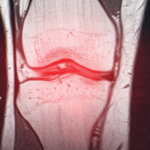 ATLANTA—People with rheumatoid arthritis (RA) and juvenile idiopathic arthritis (JIA) have recurring joint inflammation with a strong tendency to flare. Past research led by Margaret Chang, MD, PhD, a pediatric rheumatologist in the Division of Immunology at Boston Children’s Hospital, used a novel murine model to identify a population of memory T cells that persist in the synovium with a distinct resident memory T cell phenotype in recurrent, joint-specific inflammation.1
ATLANTA—People with rheumatoid arthritis (RA) and juvenile idiopathic arthritis (JIA) have recurring joint inflammation with a strong tendency to flare. Past research led by Margaret Chang, MD, PhD, a pediatric rheumatologist in the Division of Immunology at Boston Children’s Hospital, used a novel murine model to identify a population of memory T cells that persist in the synovium with a distinct resident memory T cell phenotype in recurrent, joint-specific inflammation.1
Last fall at the 2019 ACR/ARP Annual Meeting, Dr. Chang and her colleagues presented their latest findings on these cells as a potential target to reduce arthritic flare.2
Targeting Flares
Resident memory T cells are site-specific memory T cells that reside long term in peripheral tissues as a defense against pathogens. However, these cells can also cause recurrent inflammation locally. Certain rheumatologic diseases, such as RA and JIA, are characterized by recurrent joint inflammation that exhibits a strong tendency to flare at the same sites.
To understand how resident memory T cells may be manipulated for therapeutic aims, Dr. Chang and colleagues used a murine model of site-specific recurrent synovitis.1 They used intra-articular injection of adeno-associated virus to label synovial T cells in fluorescent reporter mice, tracking the site-specific persistence of resident memory T cells. They used a single intra-articular injection of diphtheria toxin in mice with Lck-inducible diphtheria toxin receptors to locally deplete synovial T cells prior to triggering an arthritis flare. Depletion of synovial T-cells made the joint relatively resistant to developing inflammatory arthritis. This approach demonstrated the contribution of synovial resident memory T cells to the flare response.
The results showed synovial resident memory T cells persist in previously inflamed joints eight months after remission and retain their capacity to trigger site-specific flare. Adeno-associated, virus-labeled resident memory T cells present in the synovium during remission did not migrate to the contralateral joint. These cells enabled joint inflammation by recruiting effector lymphocytes to the joint, and correspondingly, the localized depletion of resident memory T cells strongly blunted the capacity to trigger flare arthritis.
Managing Flares Without Immunosuppression
Dr. Chang says the hope is to target resident memory T cells in the joints experiencing flares and deplete the cells locally.
“Many of our patients with RA and JIA have to remain on systemic therapies to stay in remission. By locally depleting these [resident memory T cells], we theorize that sustained disease control or even an effective cure could be achieved without the need for systemic immunosuppression,” she says.


